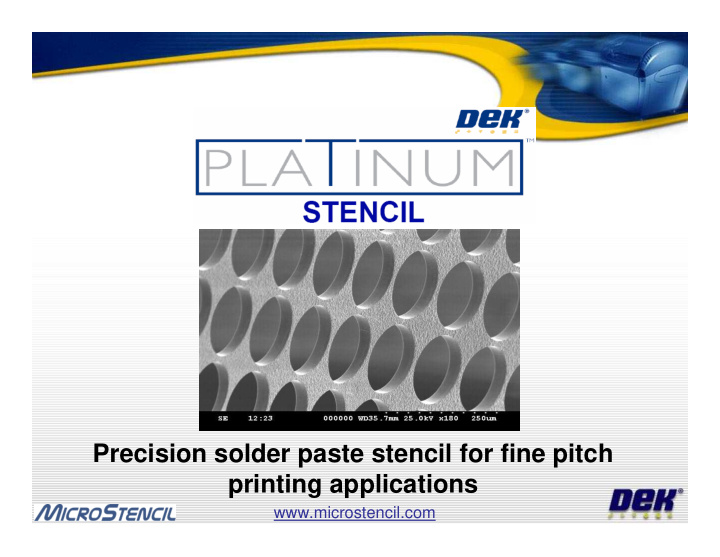



www.microstencil.com/stencil.html www.microstencil.com/stencil.html www.microstencil.com/stencil.html www.microstencil.com/stencil.html Precision solder paste stencil for fine pitch printing applications www.microstencil.com
Overview • A Microengineered electroformed stencil manufactured using semiconductor fabrication processes techniques • This high precision stencil is designed for Semicon printing applications and other fine pitch or high yield printing requirements www.microstencil.com
Target Markets • Wafer printing – Solder paste and ICA materials • Flip-chip substrate bumping – Flux printing and paste printing • Other fine pitch printing requirements www.microstencil.com
Stencil apertures examples– SEM images 175 micron diameter aperture 100 micron diameter aperture 225 micron pitch 7.5 µ m diameter circular 50 � m pitch 45 � m diameter 60 � m pitch 30 � m diameter circular apertures circular apertures aperture www.microstencil.com
High aperture tolerances • Apertures tolerances within 3µm across 200mm diameter wafer for a 50µm thick stencil www.microstencil.com
Deformation from the mounting process • Modelling studies detect only elastic deformation in the stencil from the mounting / framing process. • Through tight process control all Platinum stencils will be better than 0.2 µm/mm deformation across the design area after mounting. This spec equates to less than +/- 40 µm on a 200mm diameter wafer. www.microstencil.com
Surface roughness + stencil hardness • Low surface roughness on top side and bottom side of stencil Smooth squeegee side of stencils inhibits fine PSD – solder pastes smearing on stencil surface during printing therefore allowing a lower print pressure. Smooth substrate side improves the seal during – printing onto wafers and allows an effective underside 1000 times magnification stencil cleaning process • 10 measurements average, scan area 0.71mm x 0.53mm Squeegee side – • rms = 0.09875 � m, Ra = 0.056 � m Board side – • rms = 0.0694 � m, Ra = 0.0388 � m • Stencil hardness 480-550HV (hardness Vickers) Note: Stainless steel 220HV – Interferometer surface scan www.microstencil.com
Competitive advantages • Perfectly formed apertures with tight aperture tolerances across the whole stencil • Smooth aperture sidewalls to aid paste release • Good dimensional match to customer layout data • Uniform thickness distribution across the design area to ensure each aperture prints the same volume of solder paste • Smooth and flat substrate side of the stencil which minimises stencil cleaning frequency – In addition a smooth underside of the stencil can enable on- printer cleaning techniques not normally possible with conventional E-form stencils for wafer level printing www.microstencil.com
Product Specifications • Available thickness: 20 µm to 230 µm at 0.5 µm increments. • Thickness Variation: +/- 5% of requested thickness, across the design area • Aperture capability: >= 25 µm • Aperture size tolerance: – <3 µ m for 50 µ m thick stencils – 4 µ m for 50-100 µm thick stencils – 6 µ m for 100-200 µ m thick stencils – 8 µ m for 200-230 µ m thick stencils • Positional Accuracy: 0.2 µm / mm • Pitch: >= 50 µm www.microstencil.com
What can this stencil achieve? www.microstencil.com
Wafer printing - 60 micron pitch, 6-inch wafer (images courtesy of Technical University of Berlin) Developmental type 8 paste. Powder size Electroformed nickel apertures 35µmx 80µm at 60µm pitch. Stencil thickness: 20µm range 2-8µm. Print deposits at 60µm pitch. Wafer printing at 60µm pitch with type 8 paste. Ref:erence : Wafer printing at 60µm pitch with type 8 paste. D. Manessis, R. Patzelt, A. Ostmann, R. Aschenbrenner, H. Reichl, R. W Kay, E. de Gourcuff “ Latest technological advancements in stencil printing processes for Ultra-fine-pitch flip chip bumping down to 60µm pitch ”, IMAPS San Diego, Ca, 2006 www.microstencil.com
Case Study – 60 micron pitch 6-inch wafer bumping (images courtesy of Technical University of Berlin) . Bump height distribution at 60µm pitch, Average height: 28µm Shear mode for bumps at 60µm Pitch, fracture Cross section of bumped chip at 60µm pitch. Ref:erence : occurs in the solder D. Manessis, R. Patzelt, A. Ostmann, R. Aschenbrenner, H. Reichl, R. W Kay, E. de Gourcuff “ Latest technological advancements in stencil printing processes for Ultra-fine-pitch flip chip bumping down to 60µm pitch ”, IMAPS San Diego, Ca, 2006 www.microstencil.com
Flip Chip substrate - 150µm pitch www.microstencil.com
Technical Contact / Questions? Dr. Robert Kay Cheif Technical Officer 115A Commonwealth Drive, #04-01, Singapore, 149596 Main Line: +65 6484 7010 Direct Dial: +65 6419 5852 Email: r.w.kay@microstencil.com Internet: www.microstencil.com MicroStencil Ltd, 13 Ladysneuk Rd, Stirling, UK General enquires: sales@microstencil.com DEK Printing Machines Ltd, 11 Albany Road, Granby Industrial Estate, UK www.microstencil.com
Recommend
More recommend